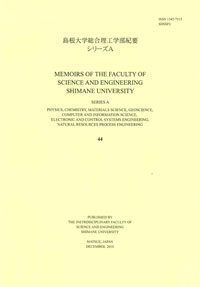島根大学総合理工学研究科
ISSN:1342-7113

ダウンロード数 : ? 件
この文献の参照には次のURLをご利用ください : https://ir.lib.shimane-u.ac.jp/3578
島根大学総合理工学部紀要.シリーズA 30
1997-03-25 発行
石州粘土瓦の光学顕微鏡および走査型電子顕微鏡による観察
Optical Microscopy and Scanning Electron Microscopy of Sekishu Clay Rooftiles
北野 保行
小野 興太郎
北坂 勝広
岸本 秀樹
兒玉 光司
村田 豊
新田 隆義
塩村 隆信
田辺 英司
ファイル
内容記述(抄録等)
Optical and Scanning Electron Microscopic investigations were performed for clay rooftiles produced at Gotsu of Shimane in Japan. The clay rooftiles have been traditionally called 'Sekishu Kawara' and famous for their high quality. It has about 25% shear of all Japanese product. Before firing in a tunnel kiln, the clay rooftiles consist of Kaolinite (Al_2Si_20_5(OH)_4) and quartz. They show lamella structures. After the firing at 1493 K ( 1220℃), however, they change to mullite and several Si0_2 related materials. The lamella structures disappear.
From the X-ray diffraction analysis, chemical formula for the firing reaction would be 3Al_2Si_20_5(OH)_4→Al_6Si_2O_13+4H_20 + 6H_2O; that shows, kaolinite changes into mullite, cristobalite and water. As minorities, K, Na, Ca and Mg are detected all over the area and some types of oxides of Fe,Ti,Mn and Zr stud‘Kawara'.The result of the chemical analysis in this study is as follows: SiO_2 related materials 70.2%,mullite 22.3%,iron oxide 3.7% and others.
Microscopic images of the rooftiles exhibits extremely rough shape. Holes or tunnels with three dimensional complex figure are observed in the SEM images. The smallest diameter of the holes or tunnels in the rooftiles is 1 or 2 micrometers.These holes or tunnels would be open pores. On the other hand,the SiO_2 related materials show small closed pores whose diameteris in order of a tenth of one micrometer.The total volume of the holes or tunnels are estimated to be 24% of the whole volume of the rooftile.
Huge volume of vapour comes out of the clay during the firing at 1493 K in the tunnel kiln.The vapour would be one of the impotant factors in forming the complicated three dimensional figure in the mullite of the roofiles.
From the X-ray diffraction analysis, chemical formula for the firing reaction would be 3Al_2Si_20_5(OH)_4→Al_6Si_2O_13+4H_20 + 6H_2O; that shows, kaolinite changes into mullite, cristobalite and water. As minorities, K, Na, Ca and Mg are detected all over the area and some types of oxides of Fe,Ti,Mn and Zr stud‘Kawara'.The result of the chemical analysis in this study is as follows: SiO_2 related materials 70.2%,mullite 22.3%,iron oxide 3.7% and others.
Microscopic images of the rooftiles exhibits extremely rough shape. Holes or tunnels with three dimensional complex figure are observed in the SEM images. The smallest diameter of the holes or tunnels in the rooftiles is 1 or 2 micrometers.These holes or tunnels would be open pores. On the other hand,the SiO_2 related materials show small closed pores whose diameteris in order of a tenth of one micrometer.The total volume of the holes or tunnels are estimated to be 24% of the whole volume of the rooftile.
Huge volume of vapour comes out of the clay during the firing at 1493 K in the tunnel kiln.The vapour would be one of the impotant factors in forming the complicated three dimensional figure in the mullite of the roofiles.
About This Article
NCID
AA11157087
Other Article
